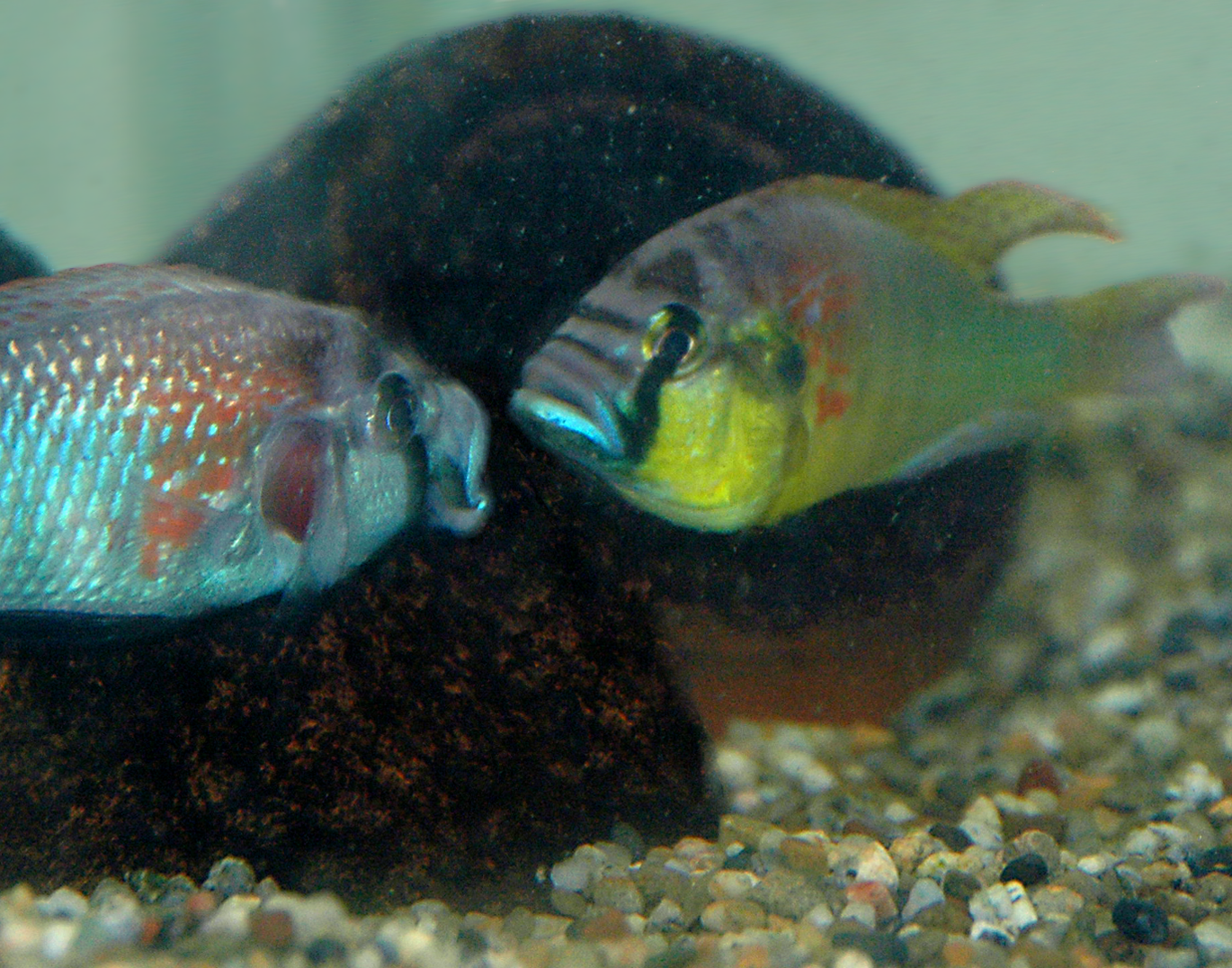Because of their aggressive and intimidating behavior, dominant male individuals occupy central positions in social interaction networks and have strong influence on group movement, but the same characteristics do not facilitate consensus formation in a social learning task, study finds.

Dominant male Astatotilapia burtoni dispute a territorial boundary. Image: Russell D. Fernald and Sabrina S. Burmeister). Source: Social Opportunity Produces Brain Changes in Fish. PLoS Biology (2005) e390 doi:10.1371/journal.pbio.0030390; License: CC BY 2.5
A new behavioral study by scientists from the University of Texas at Austin (USA), the Max Planck Institute of Animal Behavior in Konstanz (Germany), and the University of Konstanz (Germany) found that, in a species of social, ray-finned fish, the influence of dominant individuals on the behaviour of group members was highly context dependent: During routine social interactions, dominant individuals strongly influenced the movement of the group and were at the center of aggressive interaction networks. In a complex social learning task with otherwise naïve individuals, trained dominant males were worse demonstrators than trained subordinate males.
Is dominance a good leadership approach?
The authors of the study state that the mechanisms of attaining positions of social power and dominance are common across systems and societies in animals and humans. For example, aggression, coercion, and selfish manipulation of group resources is a common and viable approach to climbing up a corporate ladder. Dominant leadership can have its benefits in situations of conflict or if fast or economic decisions have to be made. In situations where cooperation and consensus are vital, dominant traits can be disadvantageous and even destructive, the study suggests, and it may be the more modest voices to which we should lend our ears.
Summary:
- A new behavioral study by scientists from the University of Texas at Austin (USA), the Max Planck Institute of Animal Behavior in Konstanz (Germany), and the University of Konstanz (Germany) found that, in a species of social, ray-finned fish (Astatotilapia burtoni), dominant males drove group movements during routine social interactions, but did not have an influence on group performance in a complex social learning task. Instead, in this consensus task, groups strongly benefited from the presence of a subordinate demonstrator.
- For the description of behavioral traits that separate dominant from subordinate individuals, AI-based animal tracking and behavior analysis tools were combined with interaction network analyses to allow new insights of unprecedented detail.
- For the social learning experiments, groups of 8 individuals were trained in a consensus learning task in which the group learned to swim towards a rewarded visual stimulus within a short time limit. In the critical experiments, new learning groups were formed with seven naïve animals and one experienced animal that was either dominant or subordinate. The number of experiments needed to learn the task was compared between groups with dominant or subordinate demonstrators.
- The code for controlling the behavioural experiments and for data analyses is freely available at the GitHub repository of the authors.
- The study received funding from the National Science Foundation (NSF) “Bio/computational Evolution in Action Consortium” (BEACON) and the Deutsche Forschungsgemeinschaft (DFG) Cluster of Excellence 2117 “Centre for the Advanced Study of Collective Behavior” (Grant #422037984)
- Original publication: Mariana Rodriguez-Santiago, Paul Nührenberg, James Derry, Oliver Deussen, Fritz A Francisco, Linda K Garrison , Sylvia F Garza, Hans A Hofmann, Alex Jordan (2020) “Behavioral traits that define social dominance are the same that reduce social influence in a consensus task.” PNAS 117 (31) 18566-18573; doi:10.1073/pnas.2000158117
Social rank and social influence can dissociate
The scientists used recent advances in machine learning for positional tracking and behavior analyses in groups of eight fish to explore information flow within the groups and to answer the question if dominance and influence are strictly associated. The animals’ behavior was observed and analyzed in two fundamentally different situations, during routine social interactions and in a social learning task, in which the animals had to act in consensus and move as a group.
In the routine context, individuals classified as dominant based on their morphology showed highly contentious behavior, chasing and pushing the other fish around. As a result, dominant fish were found at the center of aggressive interaction networks and had a strong influence on the movements of the other group members. They also were spatially more separate, as the subordinate fish tried to keep a safe distance.
In the second, more complex context, fish were trained in a consensus task, in which the fish had to identify the location of a specifically coloured light source and to collectively swim towards it within a short time. When the animals had learned the task, trained dominant and subordinate individuals were transferred to the critical experiment: They were used to fill otherwise naïve groups as the only informed individual and consensus learning started all over again. The experiments showed that the presence of a dominant informant did not speed up group learning. Groups with a subordinate informant, on the other hand, learned the task and found consensus much faster than both, groups with dominant informants and fully naïve groups.
The results show that social rank and social influence can dissociate: The characteristics that help dominant individuals to achieve and consolidate their position at the top of the social hierarchy, such as being aggressive, competitive, and using force on others, reduce their influence in situations where collaboration and consensus matter. This has important consequences for our understanding of corporate leadership.